Could the Rivian R3 EV revitalize a stagnant small car market?

Rivian delivered what was expected on Thursday – this Electric SUV R2. And then it stole the stage from the R2 with products that electric vehicle fans, investors and buyers didn’t know they needed: the Rivian R3 and R3X.
Shortly after the reveal, I noticed that while many fans were looking at the R2, there was a buzz surrounding the R3. And Rivian executives themselves seemed excited about these compact electric vehicles – including Rivian’s chief designer Jeff Hammoud.
“What I love most about the R3 is that I asked a few people: What kind of car would you call this? Is it a hatch or an SUV? And no one really has an answer, and that’s great.”
Hot hatch, rally car, trail runner? All of the above
“When I first talked to RJ about it, we went through the concept and the conversation we had was just like this: I don’t want to fall into a segment, I want people to just say it’s an R3. “ Hammoud recalled in a question and answer session with the media. “And I think we succeeded.”
Hammoud added that the goal with the powerful R3X version was just something that was really fun. “Hopefully you’ll look at this and agree that I don’t know what it is, but I just want to drive it.”

Rivian R3X
To me, it’s hard to believe that the R2 and R3 share so many features – even their front-end design – as they impress as completely different design statements and personalities. The R3 follows in the footsteps of eccentric hatchbacks like the Lada Niva and Golf Country, but could also win the hearts of many Subaru Crosstrek owners.
The R3 family is 170.3 inches long and has a wheelbase of 110.2 inches. This makes it about 15 inches shorter than the R2, which in turn is about 15 inches shorter than the R1S.
Today this is close to the length of the Hyundai Kona Electric, Volkswagen ID.3, Renault Megane E-Tech or MG4 among electric vehicles. And what’s more, it’s practically in the same size class as the Toyota Corolla hatchback, the Volkswagen Golf, the Škoda Octavia, the Ford Focus or the Seat León. But it looks more exciting than any other – or an American market, of course Bolt EV or leaf.
We have to wait a little longer. If the R2 arrives in early 2026, an R3 could follow relatively soon after. Unfortunately, the timeline for the next generation Bolt EV and Leaf doesn’t look much better. And while Rivian has confirmed that it wants to make the R3, it hasn’t confirmed when reservations might be taken or where it might be sold for sure.
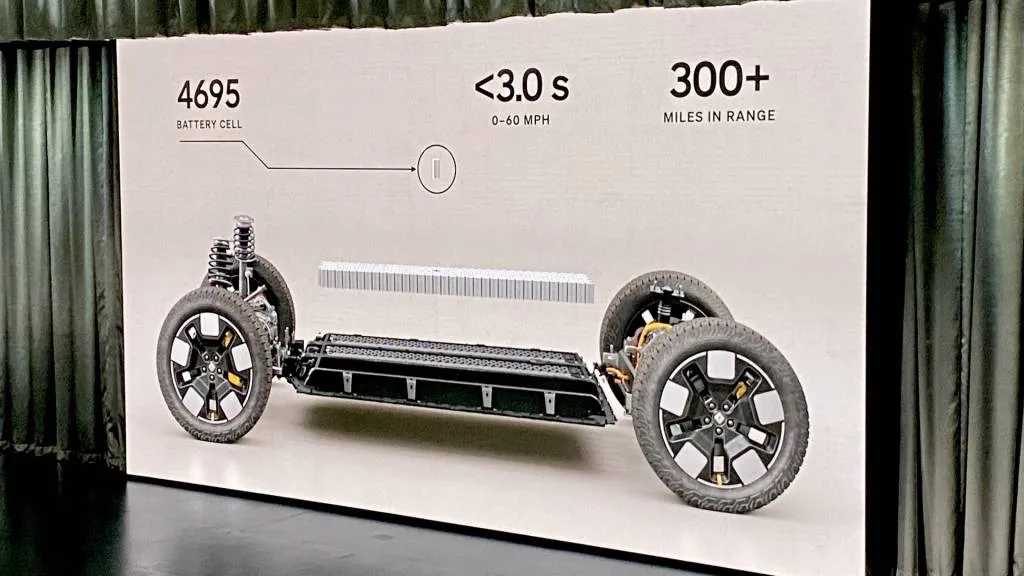
Rivian R2
Details about range and battery will follow
These models feature 4695 format cylindrical cells housed in a structural battery pack. Rivian hasn’t commented on the R3’s range yet, but Hammoud did comment a bit on charging. The vehicles shown on Thursday all had their NACS charging ports in the rear right quadrant under a neat little flush cover.
“We did a lot of research, especially in left-hand drive countries in Europe,” Hammoud said when asked why it was there. “We saw a lot of people charging cars on the street and you would see everything from charging cables wrapped over car hoods to get to the other side and we wanted to solve that.”
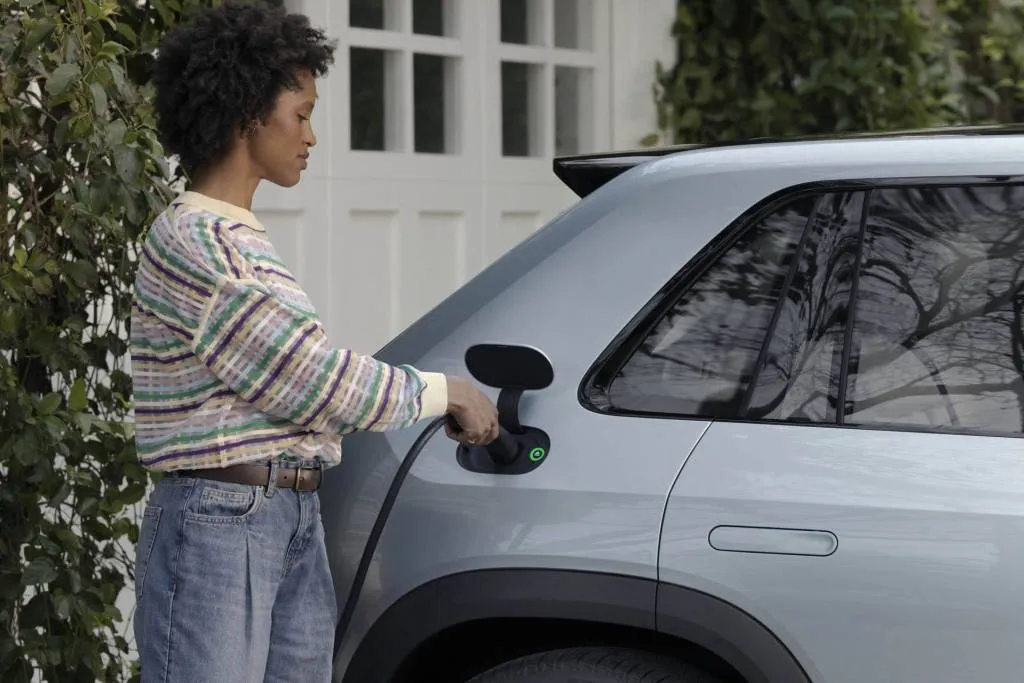
Rivian R3
“The other thing is that we are building our current charging network on the driver side. So if you throw the car back in the room, it’s essentially the exact same place.”
Placing the connection there, says Hammoud, also means fewer cables, less weight and lower costs – for the entire R2/R3 family
Which leads to a point. Although the R3 and R2 do not share sheet metal, Hammoud says there are many common points in the interior of these two models that make it easier from a manufacturing perspective. The same steering wheel, our screen strategies, the center console, the seat frames.

Rivian R2
The R2 design wasn’t that simple
While the R3’s design was fun tonally, the R2’s design process, as described by Hammoud, sounded more sophisticated – as it met the expectations of those who loved what they saw in the R1 but wanted something more affordable or of a more reasonable size.
The R1 was designed by addition, Hammoud recalled, but with the R2 there was much more debate about what R2 should not subtract and what were the most important things that needed to be carried over. This is no surprise; Rivian CEO RJ Scaringe has said at several points that the successor will be less complex than the R1 series and much easier to build.
Rivian juggled wheelbase length and glass roof placement to maximize rear headroom and spaciousness. European pedestrian protection standards also played a role, requiring a line on the side of the hood, which was then integrated into the design itself.
As Green Car Reports reported on the debut yesterday, the Rivian R2 will hit the market in early 2026 with a target price of around $45,000, starting with single-motor rear-wheel drive but also two- and three-motor AWD versions that offer a number of other options offer more than 300 miles (less in base form, it is now said) and in some cases 0-60 miles per hour in less than 3.0 seconds. In the end, the team had an overall length of about 185 inches and a wheelbase of 121.1 inches, with an overall height of 66.9 inches and a width of about 75 inches.
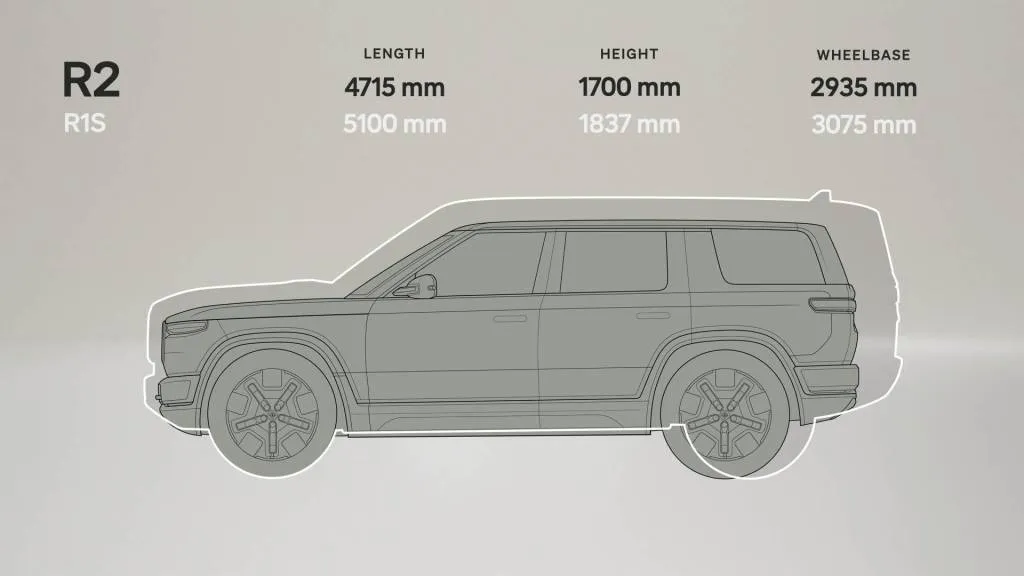
Rivian R2
According to Hammoud, the R2 builds on the profile of the R1S, although the vehicle’s overall proportions are “much more athletic” and feature very short overhangs front and rear. As shown, it had 32 inches of off-road rubber, and the approach angle of 25 degrees, approach angle of 27 degrees, and ground clearance of 9.8 inches gave it a stocky, off-road look.
Meanwhile, shorter vehicles can present a greater aerodynamic challenge, and so getting this part right to maximize range with smaller battery packs was of course a priority. “We worked very closely with our aerodynamics team and carried out computational fluid dynamics (CFD) analysis very early on to understand the key attributes required for range,” said Hammoud. In the case of the R2, one of these is the way the roofline slopes backwards, directing airflow through a full-length spoiler.
The big negative is the suspension, which cannot be raised or lowered. That won’t be the case with the R2, although they’ve taken care to give it a tune that works both on and off-road, enabling performance over ground clearance. The R2 offers 9.8 inches of ground clearance, while the R1S securely occupies its top off-roader spot for the brand with its adjustable air suspension and up to 14.9 inches.
And a third row in the R2 is not planned. “Having a third row for R2 would make the package very tight.”
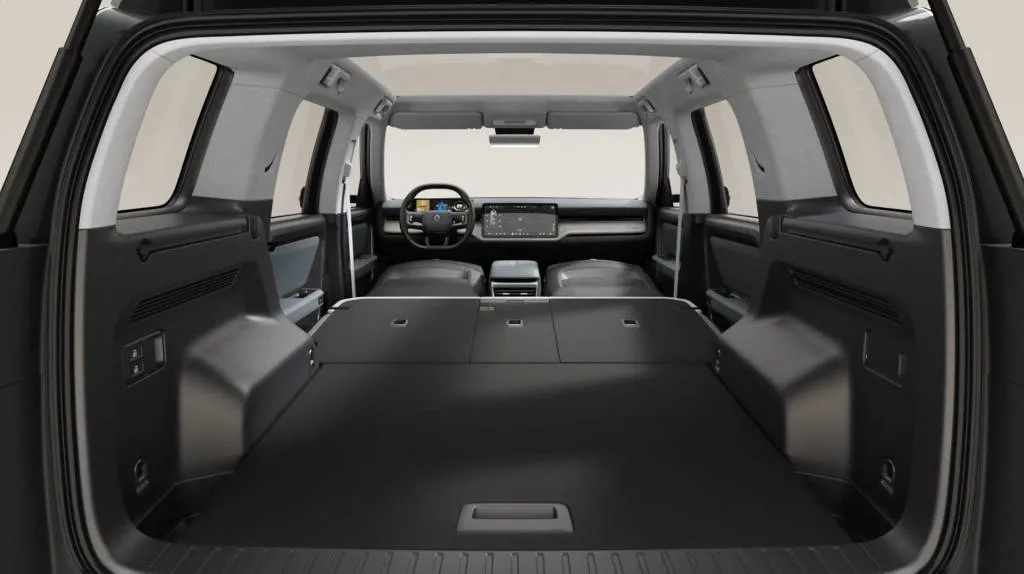
Rivian R2
Lots of innovations in R2
Still, there are some serious innovations in the R2’s packaging – like the front and rear seats that fold completely flat, providing enough continuous length to carry very long project items like a 16-foot baseboard trim that sits on the edge the tailgate rests (the glass rolls down). Once the window is closed, don’t forget the small table where you can place drinks or small items while you prepare for the outdoor activity of your choice. And dogs will probably love the breeze blowing through the fold-out windows in the back.
In the adventure sector, the R2 has a completely new bike rack system that can be set up by one person and stored much more easily. Rivian plans to offer both a bed for sitting on the flat floor and a rooftop tent, and a revamped camp kitchen is in the works.
The complex structure of the R1S’s split tailgate was one of the most difficult problems for the R2 to solve. Owners really like the R1S tailgate and “the ability to sit there and essentially have a little awning that covers you when it rains,” he described, but that comes with cost and complexity. So Rivian’s solution with a one-piece tailgate was a pull-out shelf that you can sit on.
As for the interface, the steering wheel and its large knobs have been touted several times. Two Haptic Twist controllers in the wheel use different types and levels of haptic feedback, depending on what you are currently scrolling through or selecting.

Rivian R3
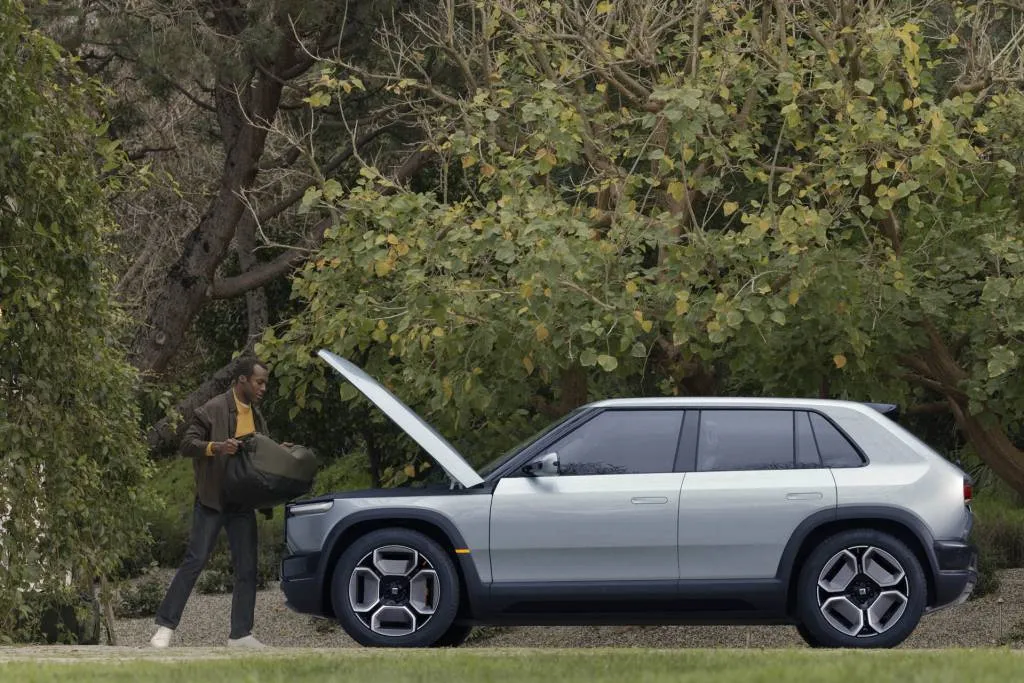
Rivian R3
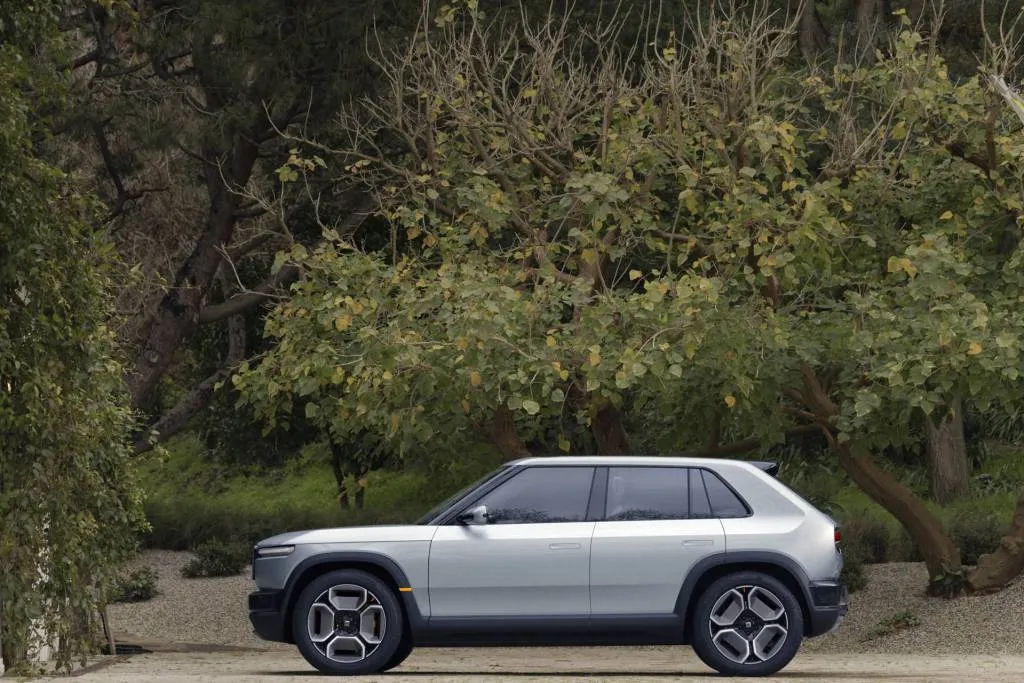
Rivian R3
R2, R3, R3X made for the same assembly line?
“A lot of work has gone into co-developing R3 and R2 to ensure that as a platform, a lot of components are shared and obviously a lot of the network architecture is shared,” Hammoud said, and that extends to manufacturing and the supply chain.
R2 will be slightly more dynamically focused on street performance than R1, Hammoud summarized, while R3 will be the most street-focused of the three.
Hammoud pointed to the area behind the rear wheel of the R2 and noted that if the vehicle is damaged, it is just an injection molded part that can be easily replaced. And he said there were also a lot of similarities between the R2 and R3’s interiors that made it easier from a manufacturing perspective – like the same steering wheel, the same screen strategies, the same center console and the same seat frames.
Essentially during Rivian’s unveiling of the R2, R3 and R3X on Thursday, the company confirmed a huge production announcement. There will be a break in construction $5 billion factory in Georgiawhich was previously slated for a ramp in 2026 and ultimately 400,000 vehicles per year, in favor of a “capital efficient rollout” initially at its Illinois factory, with deliveries starting in early 2026.
With Rivian’s mentions of Europe and its very well-received R3 family, there could well be new priorities after last week.
